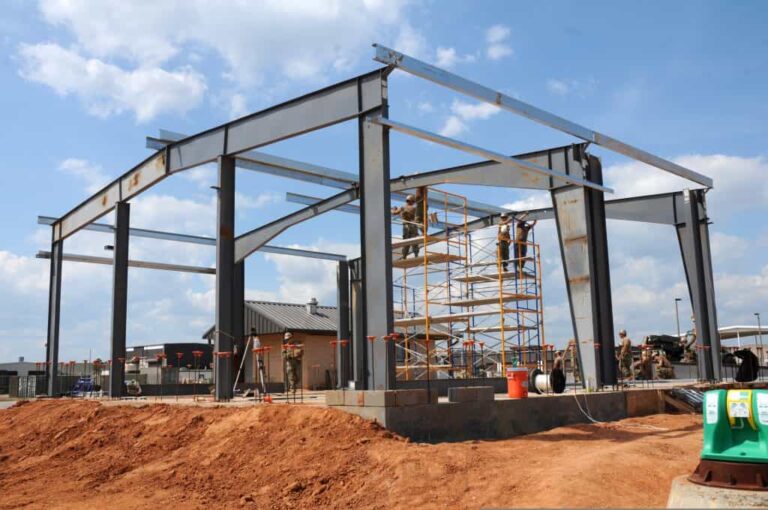Let me tell you something about boats. They’re awesome to own until you have to store them somewhere. Then all of a sudden you’ve got this big, expensive toy sitting out in the elements getting damaged every single day. I’ve seen it happen way too many times.
I was talking to a marina owner last week who told me his customers are constantly complaining about how much they spend on boat repairs from weather damage. And honestly, I get it. Nobody wants to drop thousands of dollars fixing problems that could’ve been avoided with proper storage.
That’s where pre-engineered steel buildings come into the picture. These aren’t your grandpa’s old rusty sheds. Not even close. Today’s steel buildings are basically a boat owner’s best friend, especially when it comes to cutting down those never-ending maintenance costs.
I’m going to walk you through exactly why these buildings are becoming so popular for boat storage, and more importantly, how they can save you serious cash in the long run. Because let’s be real – boats are expensive enough without adding unnecessary maintenance costs to the mix.
Understanding Pre-Engineered Steel Buildings
First things first, what exactly is a pre-engineered steel building? They’re not just regular buildings made of steel. They’re actually designed and manufactured off-site, with all the components created to fit together perfectly when they arrive at your property.
Think of it like those fancy LEGO sets where every piece has its exact place. All the structural pieces – the beams, columns, wall panels, roof – they’re all made in a factory to super precise measurements. When they get delivered to your location, everything just fits together like it should.
The cool thing about these buildings is how customizable they are. You can basically tell the manufacturer exactly what you need. Want a building that’s 100 feet wide to store multiple boats? No problem. Need extra-tall doors to fit that fancy sailboat? They can do that too.
And the best part is they go up fast. Since everything’s pre-made, you’re not waiting around for months while construction crews figure things out on site. Most of these buildings can be assembled in days or weeks instead of months.
Now, for Boat Storage Buildings specifically, these pre-engineered structures are a game-changer. They can be designed with wide-open spaces inside – no annoying support columns getting in your way when you’re trying to maneuver boats in and out. They can have custom door heights and widths to accommodate different boat sizes, and they’re built to handle the specific needs of boat storage.
I remember visiting a boat storage facility in Florida that switched from traditional wood buildings to pre-engineered steel. The owner couldn’t stop talking about how much better everything worked – from the climate control to the ease of moving boats around inside. He kept saying it was the best business decision he’d ever made.
How Pre-Engineered Steel Buildings Reduce Maintenance Costs for Boat Storage
When you’re storing boats, whether it’s your own collection or you’re running a storage business, maintenance costs can eat you alive if you’re not careful. I’ve talked to dozens of boat owners who learned this lesson the hard way.
Let me break down exactly how these steel buildings can keep more money in your pocket over time. Because honestly, that’s what we all want, right?
Durability and Weather Resistance
Steel buildings are tough as nails. That’s not just sales talk – they really are built to last decades. I’ve seen wooden structures start falling apart after just 15-20 years, while steel buildings from the 1970s are still standing strong.
The big advantage here is how they handle bad weather. Storms that would damage or destroy other buildings just bounce off steel structures. Wind, rain, snow – none of it phases these buildings much.
I have a buddy in Louisiana who lost his wooden boat shed during a hurricane a few years back. Everything inside was a total loss. He rebuilt with a pre-engineered steel building, and when another storm hit last year, his new building didn’t even have a scratch. His neighbor’s traditional storage wasn’t so lucky.
What this means for your wallet is simple: you’re not constantly paying for repairs after every storm. You’re not replacing roof panels, fixing leaks, or rebuilding sections that got damaged. Those savings add up fast, especially in areas with rough weather.
And let’s talk about rust for a second. I know what you’re thinking – “Doesn’t steel rust?” Well, modern steel buildings use galvanized or specially coated steel that resists corrosion. Many manufacturers offer 25-40 year warranties against rust and corrosion. Compare that to constantly painting and treating wood structures, and you can see why steel makes financial sense.
The sun is another big enemy of boat storage. UV rays destroy traditional materials, but steel with proper coating stands up to the sun year after year. Your maintenance schedule gets a whole lot simpler – basically just an occasional inspection instead of constant repairs.
Low Risk of Mold, Rot, and Pests
If you’ve ever dealt with mold in a wooden building, you know what a nightmare it can be. Steel doesn’t support mold growth like wood does. It doesn’t absorb moisture, so mold has nowhere to take hold.
This is huge for boat storage. Boats already have enough moisture issues without adding a moldy building to the mix. In a steel building, your boats stay drier, which means less mold damage to the boats themselves.
Then there’s rot. Wood structures in humid areas are basically in a constant state of decay. I visited a wooden boat storage facility in Florida that was barely 8 years old, and the owner was already replacing support beams because of rot. That’s thousands in maintenance costs that a steel building owner never has to worry about.
And don’t get me started on pests. Termites, carpenter ants, rodents – they love wooden structures. They can’t eat through steel. My cousin ran a traditional boat storage business for years, and he was spending about $2,000 annually just on pest control. That’s money you keep when you go with steel.
I was talking to a steel building owner in Texas who told me his maintenance plan for pests is basically nonexistent. No monthly pest control service, no repairs for damage caused by critters. Just another way these buildings keep your maintenance budget under control.
Low Roof and Structural Maintenance
The roof is usually the first thing to fail in any building, and repairs aren’t cheap. Steel roofs last significantly longer than shingle or even membrane roofs. Most pre-engineered buildings come with roof systems rated for 30+ years, compared to maybe 15-20 for traditional roofing.
I know a marina owner who was replacing his asphalt shingle roof every 12-15 years at a cost of about $25,000 each time. He switched to a steel building with a metal roof system, and that expense disappeared from his business plan entirely.
The structural maintenance is minimal too. Steel doesn’t warp, twist, or bend with age like wood does. The walls stay straight, the roof doesn’t sag, and the doors continue to function properly year after year.
This matters a lot for boat storage. When structural elements shift in wooden buildings, it can create clearance problems for moving boats in and out. That doesn’t happen with steel. The dimensions you start with are the dimensions you keep, which means fewer accidents and less damage to the boats being stored.
I remember visiting a 25-year-old steel boat storage facility in Michigan. The owner showed me his maintenance records, and structural repairs were basically zero over that entire time. He estimated he’d saved over $100,000 compared to what he would have spent maintaining a wooden structure of the same size.
The best part about low structural maintenance is that it’s predictable. You can actually budget for it accurately instead of constantly getting hit with surprise repair bills.
Energy Efficiency and Climate Control
Here’s something people don’t always think about: heating and cooling costs. If you’re running a climate-controlled boat storage facility, energy costs are a major expense.
Steel buildings can be insulated to amazing levels of efficiency. The design allows for continuous insulation without the thermal bridges you get in traditional construction. This means lower heating and cooling costs month after month, year after year.
I visited a climate-controlled boat storage facility in Arizona that switched from a traditional building to a pre-engineered steel structure. The owner showed me his utility bills before and after – he was saving about 40% on energy costs in the new building. For a large storage facility, that translated to thousands of dollars every month.
The tight construction of steel buildings also means fewer drafts and air leaks. The components fit together precisely, creating a more sealed environment. This is especially important in humid areas where you’re trying to control moisture levels around expensive boats.
Modern pre-engineered buildings can also be designed with specialized ventilation systems that help control humidity without running air conditioning constantly. This kind of smart design directly impacts your bottom line through lower utility costs.
I talked to a boat storage owner in Florida who installed a steel building with a specialized ventilation system. He told me his dehumidification costs dropped by over 50% compared to his old building, while providing even better protection for his customers’ boats.
Conclusion
When you add up all these benefits – the durability, the weather resistance, the lack of pest problems, the minimal structural maintenance, and the energy efficiency – pre-engineered steel buildings are clearly the winner for boat storage when it comes to controlling maintenance costs.
I’ve seen too many boat owners and storage facility operators waste thousands of dollars fighting constant maintenance battles with traditional buildings. It’s like throwing money into a hole that never fills up.
The upfront cost of steel buildings might be a bit higher in some cases, but the long-term math isn’t even close. Over 20-30 years, you’ll spend a fraction on maintenance compared to traditional construction.
If you’re considering a building for boat storage, whether for your personal collection or as a business, do yourself a favor and look seriously at pre-engineered steel options. Your future self will thank you when you’re not constantly writing checks for repairs and maintenance.
And your boats will thank you too. Better protection means less damage, less deterioration, and more time enjoying them on the water instead of fixing problems caused by poor storage conditions.
I’ve never met someone who regretted investing in quality boat storage. But I’ve met plenty who wished they hadn’t cut corners. When it comes to protecting something as valuable as boats, pre-engineered steel buildings just make sense – for your peace of mind and for your wallet.



